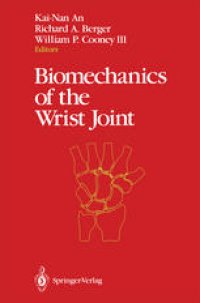
Ebook: Biomechanics of the Wrist Joint
Author: R. A. Berger M. Garcia-Elias (auth.) Kai-Nan An Richard A. Berger William P. Cooney III (eds.)
- Tags: Biomedical Engineering
- Year: 1991
- Publisher: Springer-Verlag New York
- Edition: 1
- Language: English
- pdf
Clinical interest in the wrist joint has accelerated markedly in the last two decades. Clinical diagnosis based on a greater understanding of wrist anatomy, biomechanics and increasingly sophisticated imaging techniques has markedly enhanced our ability to treat disorders of this joint. As our clinical acumen becomes better, we increasingly need more accurate understanding of the basic mechanisms by which the wrist is able to carry out its function. This book represents a compendium of work done by a number of authors in the basic sciences and their presentations at a recent workshop on biomechanics. This work, while at the forefront of current research in this area, is but an indicator of the type of information that is increasingly required to progress in this field. The authors have made some sound contributions and this book should be of considerable interest and help to those individuals who are contributing to progress in this field. It will be of even greater importance if it helps to stimulate the reader to become involved in further research into the intricacies of the wrist and help us to solve its numerous problems. I hope the reader will enjoy reading these chapters as much as I did in listening to them at the time of their presentations. Ronald L. Linscheid, M.D. President 1989-1990 American Society for Surgery of the Hand Mayo Clinic Rochester, Minnesota Preface Work related injury lIas become a major factor in current world economics.
The wrist joint is not like any other joint in the body, and biomechanically, the studies of wrist joint motion and force transmission presents very challenging engineering problems. Numerous sophisticated experimental and analytic methods have been developed or adapted particularly for a better understanding of the biomechanics of the wrist joint. A workshop for the purpose of critically reviewing these various engineering methods used for the studies, to synthesize the available findings and their clinical implications and applications, and to define the direction of future research is therefore felt to be timely by many investigators in the field. Documentation of such information will not only be important for individuals interested in wrist biomechanics and clinicians treating the wrist joint, but also beneficial to those involved in joint mechanics research in general.
The wrist joint is not like any other joint in the body, and biomechanically, the studies of wrist joint motion and force transmission presents very challenging engineering problems. Numerous sophisticated experimental and analytic methods have been developed or adapted particularly for a better understanding of the biomechanics of the wrist joint. A workshop for the purpose of critically reviewing these various engineering methods used for the studies, to synthesize the available findings and their clinical implications and applications, and to define the direction of future research is therefore felt to be timely by many investigators in the field. Documentation of such information will not only be important for individuals interested in wrist biomechanics and clinicians treating the wrist joint, but also beneficial to those involved in joint mechanics research in general.
Content:
Front Matter....Pages i-xvi
General Anatomy of the Wrist....Pages 1-22
Kinematic Analysis....Pages 23-36
Wrist Joint Motion....Pages 37-60
Individual Carpal Bone Motion....Pages 61-75
Force Analysis....Pages 77-97
Joint Contact Area and Pressure....Pages 99-126
Strain Gauge Measurement in Carpal Bone....Pages 127-138
Material Properties of Ligaments....Pages 139-156
Muscle Function....Pages 157-169
Back Matter....Pages 171-174
The wrist joint is not like any other joint in the body, and biomechanically, the studies of wrist joint motion and force transmission presents very challenging engineering problems. Numerous sophisticated experimental and analytic methods have been developed or adapted particularly for a better understanding of the biomechanics of the wrist joint. A workshop for the purpose of critically reviewing these various engineering methods used for the studies, to synthesize the available findings and their clinical implications and applications, and to define the direction of future research is therefore felt to be timely by many investigators in the field. Documentation of such information will not only be important for individuals interested in wrist biomechanics and clinicians treating the wrist joint, but also beneficial to those involved in joint mechanics research in general.
Content:
Front Matter....Pages i-xvi
General Anatomy of the Wrist....Pages 1-22
Kinematic Analysis....Pages 23-36
Wrist Joint Motion....Pages 37-60
Individual Carpal Bone Motion....Pages 61-75
Force Analysis....Pages 77-97
Joint Contact Area and Pressure....Pages 99-126
Strain Gauge Measurement in Carpal Bone....Pages 127-138
Material Properties of Ligaments....Pages 139-156
Muscle Function....Pages 157-169
Back Matter....Pages 171-174
....